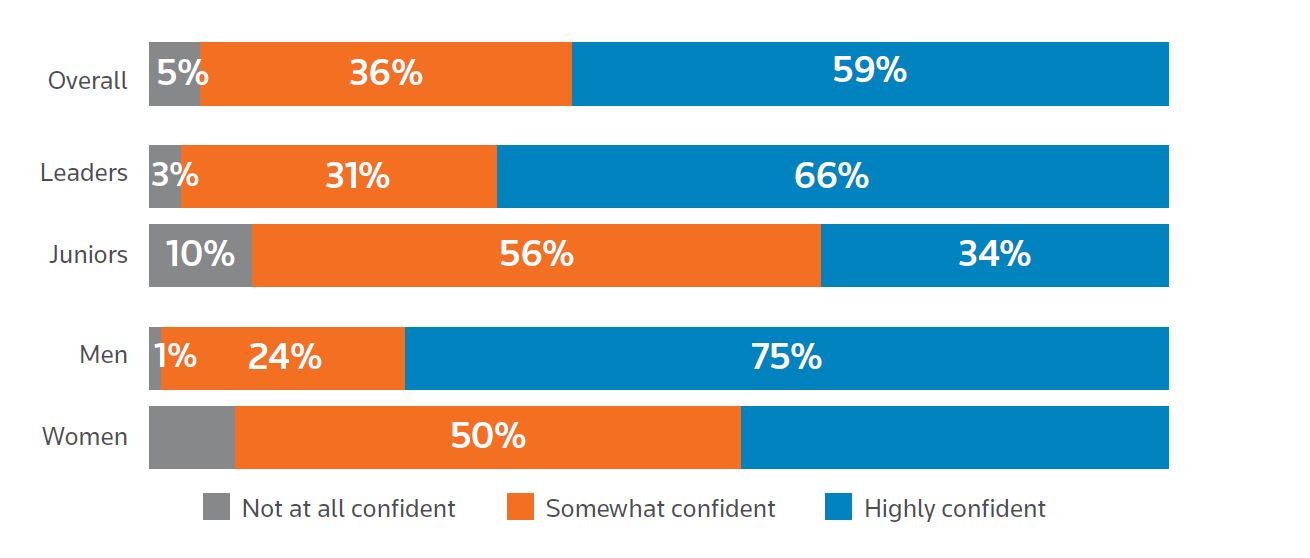The tax & accounting industry lives on accuracy and thoroughness. Yet, you may be surprised at the gap of confidence found among tax professionals and staff members within firms.
A recent survey of tax professionals by Thomson Reuters specifically shows the struggle around confidence when providing business advice.
How confident are you when offering clients business advice?

But why is that? How can those professionals who understand all of the metrics and levers of business lack confidence when giving business advice? In this the first of a two-part blog series, we will explore what contributes to this lack of confidence, and the impact it could have on your firm.
As we exam this apparent lack of confidence among tax professionals, it’s important to remember that this is not about confidence to do the work, communicate internally with other team members, nor a commentary on confidence with certain technical skills. This is solely about having the confidence to give clients business advice.
You can download a copy of the report, Insights for Tax Professionals 2021 here.
Indeed, there are four major factors that are contributing to this confidence deficit, although your firm may only face one or two. Worse yet, these factors are not only limiting the growth of confidence within your team, but also reinforcing the current lack of confidence in giving business advice.
These factors are:
-
-
-
- Your firm’s internal focus is only completing tasks, not managing clients.
- Critical client conversations are limited to top-level firm members.
- Client relationships are purely structured around compliance work.
- There is little or no focus on improving confidence in this area.
-
-
Let’s examine each in turn.
Internal focus
The areas where your team is measured and evaluated are usually the areas which draw the firm’s focus and attention. This makes sense to a degree — after all, firms want to be sure that the client tasks are being done. However, if a firm engages in too much internal focus, it can lead towards a self-centered, myopic view of the work. When the emphasis is on the managing tasks, individuals look at what they can control — and that is too often only themselves and their work at hand. This drives the internal focus even more inward, beating against the desire the client has for quality business advice.
If a firm moves its internal focus to one centered around client management, then the psychological approach of your team changes. As teams look to measure their impact to a customer, they see their value is directly connected to the success of the customer, and not in how many individual tasks team members can complete.
This critical shift can lay the groundwork for improved confidence in delivering business advice, simply because this moves team thinking from it’s helpful to them, but not me toward it helps me because it helps them. Further, your teams’ confidence will not move forward until you make this attitudinal shift. Ask yourself: What would you measure within the areas of client management to help shift this internal focus?
Closed conversations
Traditionally, the place for any client conversation beyond missing documents was reserved for those on the level of partner or senior manager only. However, when the responsibility for communicating with clients through more complex conversations rests only with one tranche of professional for such a long time, the firm is likely to lose development opportunities for those at the other levels of the firm.
To move forward comfortably beyond this closed-loop of conversations, it’s crucial to first understand the barriers to making needed changes here. These barriers include:
-
-
- Trust — Do we trust others in the business, even if we need them to learn the skills of communicating with clients? If top-level managers cannot trust some of the firm’s lower-level team members to learn how to have these conversations, there is either a trust issue or personnel issue that must be addressed.
- Ownership — Are the client relationships the partner’s or the firm’s? Client relationships should be viewed as part of the collective instead of owned by the individual. Not only does this promote greater client loyalty by extending the relationship, it also brings a greater ownership on the part of the team members now in those conversations.
- Value — How do you measure a partner’s value to the firm? That value certainly must extend beyond specific client relationships. A leader’s time should be spent building the business and leading the team, not creating a chokepoint in the firm where things must run through that person exclusively.
-
Client relationship structure
Could it be that this lack of confidence in giving business advice stems from it not being found anywhere in your client engagement documents? At the end of the day, if business advice and advisory help is not a part of your client relationship at a formal level, it can serve as a determining factor for how team members spend their time. If your team sees that client service and client business advising is not outlined as critical in the engagement letters, then they cannot be blamed for feeling that they are not be responsible for business advice. Similarly, team members also may assume that clients either don’t or shouldn’t expect such advice-giving either, since that is not part of the agreement.
These incorrect assumptions will greatly influence how team members choose to spend their time and serve as a reinforcement in what matters to the business. If all your firm’s engagements are around technical work, for example, then that is where your team members — especially those who want to grow their skills and advance in the firm — will chose to put their efforts. How you structure your client engagements is a central element to changing the culture of confidence within your firm.
Improving confidence
If firms do not put a conscious emphasis on growing the confidence of their team members in giving business advice to clients, it will not magically appear out of thin air. Firms need to remember that this is not just a focus on confidence for the sake of confidence; rather, it is more encompassing approach that takes into consideration other elements, such as the lack of critical thinking skills among those newer to the workforce.
As firms look to address the gap of focusing on improvement in this area, they will want to deal with the entire scenario — starting with the critical thinking and then moving into the delivery of quality business advice to the client.
How could your firm effectively close this gap on confidence in giving business advice? Are firm leaders have an organized approach to moving the needle on the confidence level within your firm?
This blog post was written by Will Hill, MBA, owner of Will Hill Consults
In the second part of this series, we will examine practical and proven steps you can take in each of these challenge areas.







